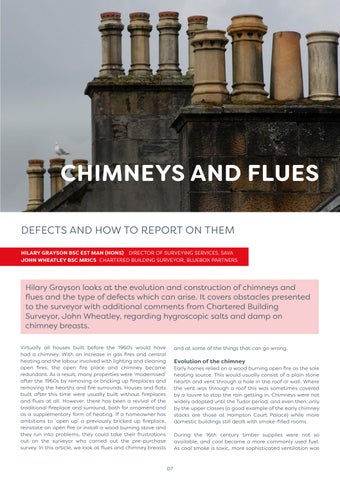TECHNICAL BULLETIN
ISSUE 30
NOVEMBER 2018
CHIMNEYS AND FLUES DEFECTS AND HOW TO REPORT ON THEM HILARY GRAYSON BSC EST MAN (HONS) DIRECTOR OF SURVEYING SERVICES, SAVA JOHN WHEATLEY BSC MRICS CHARTERED BUILDING SURVEYOR, BLUEBOX PARTNERS
Hilary Grayson looks at the evolution and construction of chimneys and flues and the type of defects which can arise. It covers obstacles presented to the surveyor with additional comments from Chartered Building Surveyor, John Wheatley, regarding hygroscopic salts and damp on chimney breasts. Virtually all houses built before the 1960s would have had a chimney. With an increase in gas fires and central heating and the labour involved with lighting and cleaning open fires, the open fire place and chimney became redundant. As a result, many properties were ‘modernised’ after the 1960s by removing or bricking up fireplaces and removing the hearths and fire surrounds. Houses and flats built after this time were usually built without fireplaces and flues at all. However, there has been a revival of the traditional fireplace and surround, both for ornament and as a supplementary form of heating. If a homeowner has ambitions to ‘open up’ a previously bricked up fireplace, reinstate an open fire or install a wood burning stove and they run into problems, they could take their frustrations out on the surveyor who carried out the pre-purchase survey. In this article, we look at flues and chimney breasts
and at some of the things that can go wrong.
Evolution of the chimney Early homes relied on a wood burning open fire as the sole heating source. This would usually consist of a plain stone hearth and vent through a hole in the roof or wall. Where the vent was through a roof this was sometimes covered by a louvre to stop the rain getting in. Chimneys were not widely adopted until the Tudor period, and even then, only by the upper classes (a good example of the early chimney stacks are those at Hampton Court Palace) while more domestic buildings still dealt with smoke-filled rooms. During the 16th century timber supplies were not so available, and coal became a more commonly used fuel. As coal smoke is toxic, more sophisticated ventilation was
07







